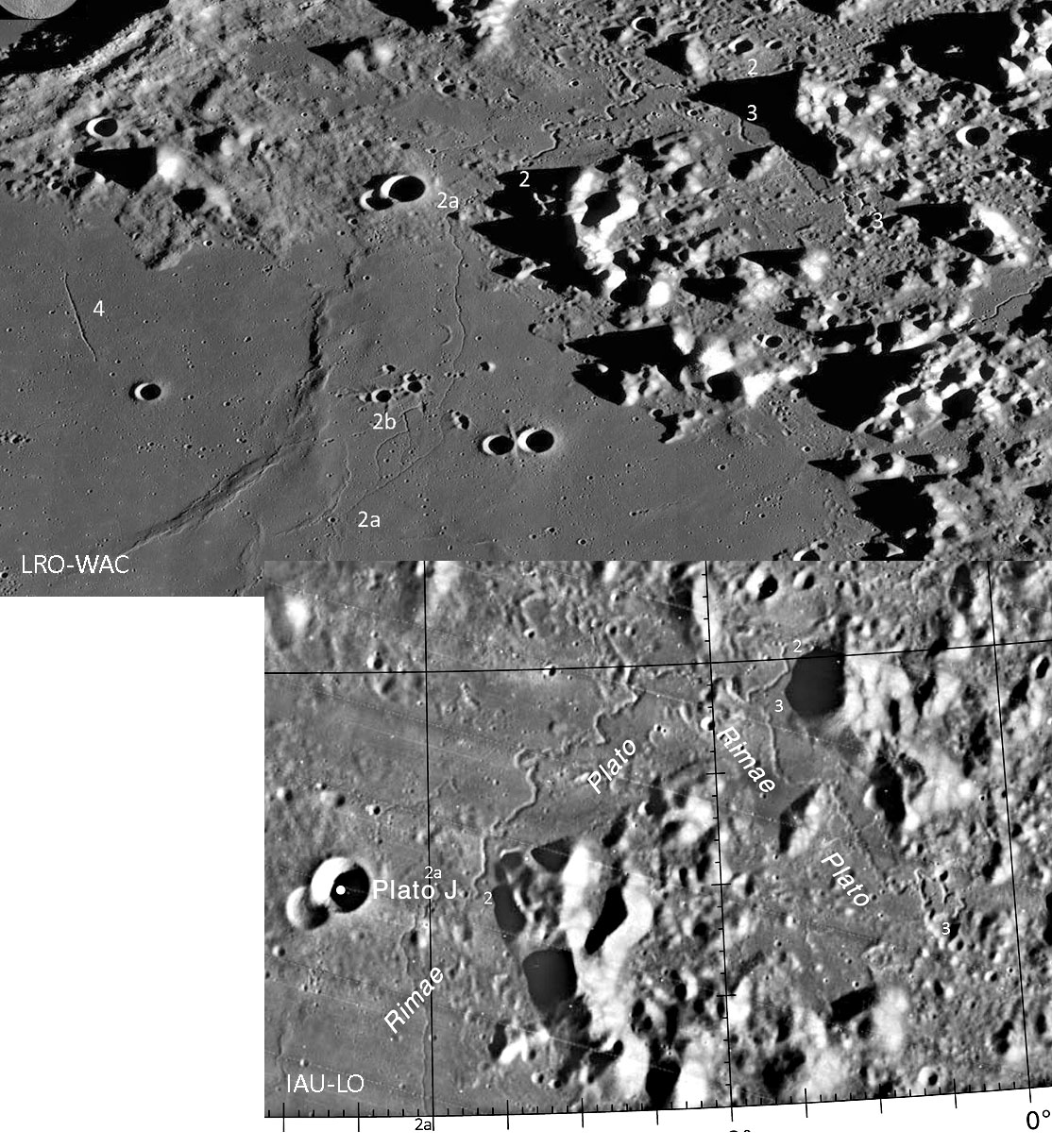August 18, 2020
Rillee Difficult
Originally published March 7, 2011

top image from LRO-WAC nearside mosaic and bottom image from 1:1 Million Maps of the Moon
The IAU approval of the System of Lunar Craters (SLC) in 1967 included not just crater names and letters
but also designations for other types of features including rilles and elevations such as mountains, hills and
domes. But no modern catalog of rilles and elevations exists, and the official IAU nomenclature as memorialized on the IAU Gazetteer of Planetary website does not include them. But now the IAU lunar nomenclature group is investigating the possibility of reinstating nomenclature for the discarded features, starting
with rilles. Part of the reason for this reconsideration is the issuance of Lunar Reconnaissance Orbiter -
Wide Angle Camera mosaics that provide high resolution image maps for resolving previous uncertainties.
Or so I assumed.
As a test of the feasibility of restoring designations for rilles I looked at the ones named for Plato. The SLC
had two, the area shown above includes one, Rima Plato II - rilles were designated with Roman numerals.
The IAU referred to both of Plato's rilles with the less precise Rimae Plato designation that simply said there
were at least two rilles named after Plato. The lower image is an excerpt from the LAC 12 sheet of the IAU
1:1 Million Nomenclature Maps of the Moon showing the name Rimae Plato along two rilles. In SLC these
were both called Plato II. The LRO-WAC mosaic (top image) suggests they may be just one rille because
the area where they meet is hidden by shadow (upper right between the 2 and 3). But LAC 12 (compiled
from Lunar Orbiter IV images) shows that in fact these two rille segments do not meet - they are two separate
rilles. I have labelled one with a 3 at each end - the bottom right end has an elongated rimmless depression
that is the source of that rille. The other rille has a 2 at each end but it is not clear which was the source. Once
again, a long shadow on the LRO mosaic covers the end. One thing that is clearly depicted on the LRO
mosaic is a very thin rille that looks to continue rille 2 onto Mare Imbrium. Because this thin rille appears to
be an extension of rille 2, but has a different morphological character, I propose calling it 2a. A very similar
narrow rille is labelled 2b, because it is near 2a, but it does have its own source vent. Finally, the gash-
like linear feature at center-left of the LRO-WAC view is peculiar, and is more like a rille than an other class
of lunar feature - I don't think it is a crater chain - so I propose calling in Plato 4. There is one definite rille
west of Plato - number 5 - and another possible one that I need to study more before making a judgement.
This exercise demonstrates that more than one image is required to identify rilles. It also shows that considerable time will be required to research rilles on SLC, make sure they are real, and single or multiple, and
also to look for previously un-numbered ones. You may notice that I didn't suggest a designation for the
little rille above Plato J. That seems too little to need a number. But I did propose 2b for an even smaller
feature because it has a source depression and might be discussed in some future paper about sources
of mare lavas. The final lesson I learned is that it isn't easy to decide how best to provide designations for
rilles. The numbers on the image above are not official - they are just an exploration and a (long) discussion
of what could be done, not that it should. And of course, rilles were traditionally numbered with Roman
numerals, and Arabic numbers have been used for domes (and Greek letters for elevations) so that rilles
would not be labelled 1, 2, 3, 4 etc, but l, ll, lll, lV, etc.
Chuck Wood
Related Links
Rükl plate 3
Yesterday's LPOD: Faint Color Speculation
Tomorrow's LPOD: Selenian Smile
COMMENTS?
Register, Log in, and join in the comments.



